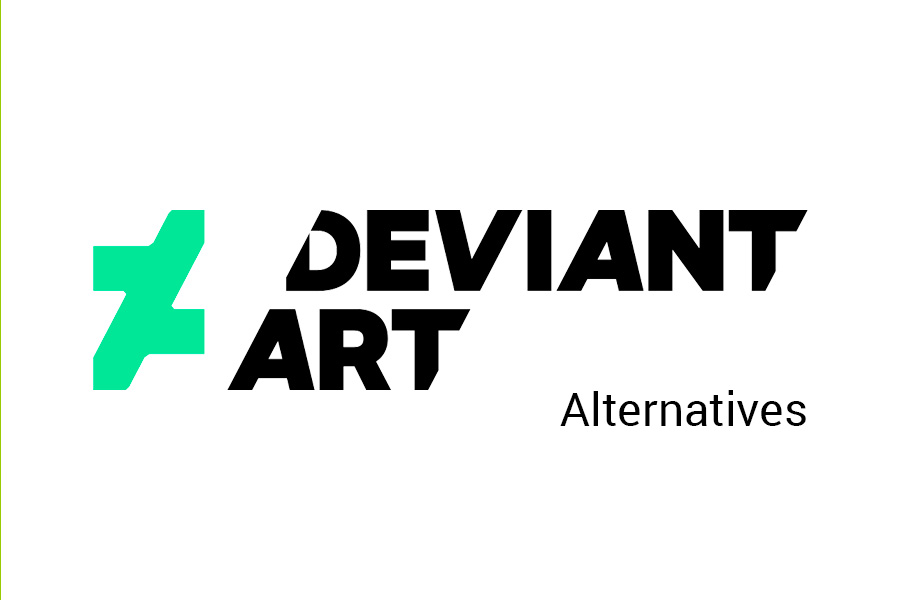DeviantArt has long been the go-to platform for artists and creative minds to share their work, connect with others, and gain inspiration. However, as the art world continues to evolve, so too do the platforms that support it. There are many reasons to look for alternatives to DeviantArt, whether you’re an artist looking for a more niche platform, want to explore new communities, or simply seek a fresh start. In this article, we’ll explore nine of the best DeviantArt alternatives, discussing their unique features, benefits, and target audiences to help you find the perfect home for your creative work.

1. ArtStation
1.1. Overview of ArtStation
ArtStation is a professional platform catering to artists in the fields of gaming, film, media, and entertainment. With a focus on high-quality artwork and a user-friendly interface, ArtStation is an excellent choice for artists seeking a more professional community.
1.2. Features and benefits
- High-quality artwork display
- Job postings and marketplace
- ArtStation Learning: Online courses and tutorials
- Social media integration
1.3. How it compares to DeviantArt
While DeviantArt has a more casual atmosphere, ArtStation is geared toward professionals and showcases a higher caliber of work. The platform also offers more career-focused features, like job postings and an online marketplace.
1.4. Best for: Professional artists and designers in the gaming, film, media, and entertainment industries
2. Behance
2.1. Overview of Behance
Owned by Adobe, Behance is a well-established platform for creatives to showcase their work, discover new talent, and find inspiration. Behance caters to a wide range of disciplines, including graphic design, photography, illustration, and more.
2.2. Features and benefits
- Integration with Adobe Creative Cloud
- High-quality project presentation
- Networking and collaboration opportunities
- Job postings and freelance opportunities
2.3. How it compares to DeviantArt
Behance is more focused on professional networking, offering a clean and polished interface for showcasing projects. The platform also has a stronger emphasis on collaboration, with team projects and the ability to follow other creatives.
2.4. Best for: Professional creatives across various disciplines, especially those using Adobe products
3. Dribbble
3.1. Overview of Dribbble
Dribbble is a popular platform for designers and creatives to showcase their work, find inspiration, and connect with potential clients. It’s especially popular among web designers, graphic designers, and illustrators.
3.2. Features and benefits
- Invite-only community ensures high-quality content
- Networking and job opportunities
- Clean, minimalistic interface
- Focus on bite-sized content (“shots”)
3.3. How it compares to DeviantArt
Dribbble has a more exclusive feel, thanks to its invite-only community. The platform is less about showcasing a diverse range of art and more focused on design, making it a better fit for designers seeking a targeted audience.
3.4. Best for: Web and graphic designers, illustrators, and creative professionals seeking networking opportunities
4. Pinterest
4.1. Overview of Pinterest
Pinterest is a visual search engine and social media platform where users can discover and save ideas in the form of images and videos, known as “pins.” While not specifically an art platform, Pinterest is a popular choice for artists to showcase their work and find inspiration.
4.2 Features and benefits
- Visually driven platform
- Boards for organizing and curating content
- Large, diverse user base
- Integration with websites and blogs
4.3. How it compares to DeviantArt
Pinterest’s primary focus isn’t on art; however, its visually driven interface and large user base make it an attractive option for artists looking to reach a broader audience. The platform is more about discovery and curation than building a community around a specific type of art.
4.4. Best for: Artists seeking a broader audience and those looking for inspiration
5. Tumblr
5.1. Overview of Tumblr
Tumblr is a microblogging platform that allows users to share and discover a wide range of content, including text, images, and videos. The platform has a strong creative community, making it a popular choice for artists and illustrators.
5.2. Features and benefits
- Customizable blog themes
- Supports multiple content types
- Active, diverse community
- Simple, easy-to-use interface
5.3. How it compares to DeviantArt
While DeviantArt focuses primarily on visual art, Tumblr supports various content types, allowing artists to showcase their work alongside other forms of creative expression. Tumblr has a more casual atmosphere and a broader range of content.
5.4. Best for: Artists looking for a versatile platform and a diverse community
6. Pixiv
6.1. Overview of Pixiv
Pixiv is a Japanese online community for artists, with a focus on illustration, manga, and digital art. The platform offers a wealth of features tailored to the needs of illustrators and manga artists.
6.2. Features and benefits
- Focused on illustration, manga, and digital art
- Daily art rankings and contests
- Pixiv Sketch: A drawing tool for creating and sharing art
- Pixiv Fanbox: A subscription-based service for monetizing content
6.3. How it compares to DeviantArt
Pixiv has a more focused audience and feature set, catering specifically to illustration, manga, and digital art. The platform is more popular in Japan, but its features and community also appeal to artists worldwide.
6.4. Best for: Illustrators, manga artists, and digital artists seeking a focused platform and community
7. Instagram
7.1. Overview of Instagram
Instagram is a popular social media platform centered around sharing photos and videos. With its visual focus and large user base, Instagram has become a popular platform for artists to showcase their work and engage with fans.
7.2. Features and benefits
- Large, diverse user base
- Stories and highlights for sharing content
- Instagram Shop for selling products
- Algorithm-driven discovery and engagement
7.3. How it compares to DeviantArt
Instagram is a more casual and mainstream platform, with a broader focus than DeviantArt. Its algorithm-driven discovery and large user base make it an attractive option for artists looking to reach new audiences.
7.4. Best for: Artists seeking exposure and engagement on a popular social media platform
8. INPRNT
8.1. Overview of INPRNT
INPRNT is an online art marketplace specializing in high-quality art prints. The platform offers a curated selection of artwork, making it an excellent choice for artists looking to sell prints of their work.
8.2. Features and benefits
- Curated selection of artwork
- High-quality art prints
- Artist-friendly profit margins
- Simple, clean interface
8.3. How it compares to DeviantArt
While DeviantArt does offer print-on-demand services, INPRNT is specifically tailored to selling high-quality art prints. The platform is more focused on the commerce aspect of art, with a curated selection of artwork and artist-friendly profit margins.
8.4. Best for: Artists looking to sell high-quality prints of their work
9. CGSociety
9.1. Overview of CGSociety
CGSociety is a professional platform for digital artists specializing in computer graphics, visual effects, and animation. The platform offers an online community, workshops, and resources for artists in these fields.
9.2. Features and benefits
- Focused on computer graphics, visual effects, and animation
- Online workshops and resources
- Networking and job opportunities
- Showcases high-quality, professional work
9.3. How it compares to DeviantArt
CGSociety caters to a more specialized audience, focusing on digital artists in the fields of computer graphics, visual effects, and animation. The platform is more professional and career-oriented, with a stronger emphasis on workshops, resources, and networking opportunities.
9.4. Best for: Digital artists in computer graphics, visual effects, and animation seeking a professional community and resources
Conclusion
There is no one-size-fits-all alternative to DeviantArt, as each platform offers unique features, benefits, and target audiences. Whether you’re a professional artist seeking a career-focused community or a hobbyist looking for a more casual platform, exploring these nine DeviantArt alternatives can help you find the perfect home for your creative work. Remember, choosing the right platform is crucial for showcasing your talent, connecting with like-minded individuals, and unlocking new opportunities.
Frequently Asked Questions (FAQs)
Why do artists need an alternative to DeviantArt?
Artists may seek alternatives to DeviantArt for various reasons, including finding a more specialized platform, exploring new communities, or simply seeking a fresh start. Different platforms cater to different needs and audiences, making it essential to find the right fit for your creative work.
What are the key differences between DeviantArt and its alternatives?
The main differences between DeviantArt and its alternatives are the target audience, platform focus, and features offered. Some alternatives cater to specific disciplines or industries, while others focus more on networking, collaboration, or selling artwork.
Can I use multiple platforms for showcasing my art?
Yes, using multiple platforms can be a great way to reach a broader audience and tap into different communities. However, it’s essential to maintain a consistent presence on each platform and tailor your approach to each platform’s unique features and audience.
How can I choose the right platform for my art style and audience?
To choose the right platform, consider factors such as your target audience, the type of art you create, and your goals as an artist. Research each platform, explore their features, and take note of the communities they cater to. You may also want to consider whether a platform offers tools and resources to help you grow as an artist.
Are there any niche platforms for specific types of art?
Yes, some platforms cater to specific types of art or industries. For example, Pixiv focuses on illustration, manga, and digital art, while CGSociety targets digital artists in computer graphics, visual effects, and animation. Researching and exploring various platforms can help you find the perfect fit for your unique art style and goals.
